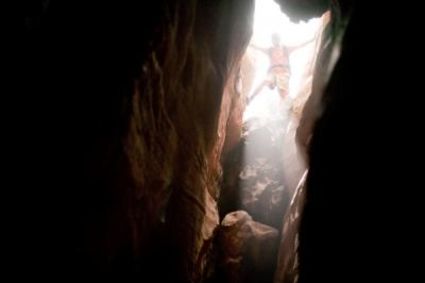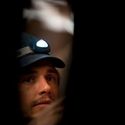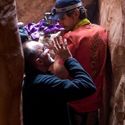127 Hours
November 11, 2010
One rock. One man. The forces of nature. A really crappy off-brand Leatherman tool. 127 hours. Who else but Danny Boyle, screenwriter Simon Beaufoy, and actor James Franco could turn that combination into one of the most exciting, suspenseful and triumphant films of the year? The answer - no one.
Aron Ralston is a mountaineer and extreme sport athlete who lives for the adrenalin rush of doing the impossible, the unthinkable and even the reckless and unsafe. His greatest passion is rock climbing, mountain climbing. By now, you all probably know Aron’s story, either hearing or reading about it in 2003 when it happened, with the release of Aron’s best-selling memoir, “Between a Rock and a Hard Place”, or now, with the buzz surrounding 127 HOURS.
On a beautiful spring day in April 2003, then 26 year old Aron Rolston went hiking in Canyonlands National Park in Utah. Having hiked and climbed there countless times before, he was anxious to head back to Blue John Canyon, an exquisite area deep within the beautiful painted desert. Unfortunately, while atop a rock formation 65 feet above ground level, Aron slipped, plummeting down into a narrow crevasse. And right behind him, tumbled a large boulder. In an effort to keep his head from getting crushed, Aron dodges the boulder, but in so doing, positions his body so that as the boulder becomes stuck between the walls of the crevasse, so does Aron’s right arm and hand, literally pinning him between a rock and a hard place.
Try as he might, the boulder was immovable. He was stuck. With his mind racing, he thought of rescue. He thought of calling someone on his cell phone for help. But then realization struck. No one, but for two girls he had met earlier in the day, even knew where he was. Aron was notorious for not returning phone calls, leaving notes or letting anyone know what he was doing or where he was going. He always felt invincible. But now... And the cell phone was of no use as there was no signal.
Keeping a cool head, much like NASA with Apollo 13, Aron took stock of what he had to work with to not only survive, but to free himself - rope, harnesses, some credit cards, head lamp, minimal water, a camel pak, video camera and a knock-off Leatherman tool. Keeping his mind busy and adapting to functioning with only one arm and hand as he worked to create a sleeping harness and chisel away at the rock with the crappy bladed tool, Aron began to reflect on his life; on what he had and what he had failed to appreciate. Using his video camera to record his thoughts and send messages to his mother and family as his “Last Will and Testament”, the direness of the situation only increased, as did Aron’s calm and resolution. As day turned into night and night into another day and another day and another day, with only 15 minutes a day of sunlight to warm him, chilling nights, torrential downpours, no food, depleted water supply, Aron realized that in order to survive, there was only one thing he could do.

This is the most powerful performance of James Franco’s career. Masterful artistry. As Aron Ralston, he is on screen 100% of the time. He is it. Even Tom Hanks had Wilson to entertain him in “Castaway”. Here, there is nothing but Ralston and 127 hours of solitude. But it’s not the physical efforts made in character or the video reflections that make the most impact, it is Franco’s presence in pure silence that are the most riveting and impactful. A physically demanding role, Franco lost an excess of 25 pounds before shooting began and then relied on face padding for the early scenes of a healthy Ralston, removing the prosthetic as days and hours progressed and his body began to emaciate from water deprivation. In reality, Ralston lost 40 pounds over the course of those 127 hours. Viewing the videos with Ralston, Franco was able to see and feel Ralston’s emotions at the time, brining them into his own performance. He recalled that while the voice messages were scripted, “I think [Danny] gave me the freedom to be a little loose with the words. The most important thing was that it feel natural.” On watching the real videos, Franco found that “one of the things that was the most powerful was how simple it was; how direct and connected it was. So to capture that, Danny allowed me some looseness.”
As we have seen time and time again, Danny Boyle is a true visionary. And with 127 HOURS, one must also add “genius.” With an artfully crafted script by Simon Beaufoy and Boyle, we are given a window into Ralston’s mind that fills the screen with meaning, courage, inner fortitude and humanity. Incorporating Ralston’s use a video camera during his ordeal not only opened up avenues for storytelling, but aided in the minimal dialogue by using many of Ralston’s own words and thoughts which were on video, many times as a basis for “fantasy” or delirium, and other times, for the sheer truth and power of Ralston’s voice. According to Franco, “Certain scenes were verbatim. Some of the video messages are verbatim what [Ralston] actually said.” Using silence as a tool, some of the most riveting sequences are Franco’s pensive reflection just staring up into the starlit inky black night. Achieving a storytelling balance, humor is also reflected in the dialogue with every child’s favorite - bathroom humor. For Boyle, “that kind of thing is crucial in these circumstances. That spark of humor shows that life is still pulsing away.”

At times his own worst enemy during production, Ralston wanted everything to be 100% by the book, word-for-word with no room for art, storytelling or naturalism. While the approach taken by Boyle, Beaufoy and Franco was to “honor Aron’s story and do everything that he did, but we also wanted to have our own approach or have the latitude to find things on our own. So we did everything, the chipping [of the rock] and everything as he did, but not matching exactly [his hand moving a certain way, etc.] but doing it on our own, figuring it out.” As to his own approach toward 127 HOURS, Boyle is adamant. “You have to take control of it. You can’t honor his story if you are in a three-legged race. If me and [Franco] are tied together, and kind of hopping along because we’re keeping an eye on Aron the whole time, you’ve got to brief yourself completely, immerse yourself in it, have this idea that you will respect his story and then make your own version of it. I’m a big believer in that.” The end result - Ralston is more than pleased.
Key to establishing the tone of 127 HOURS is a pulsating, driving soundtrack by A.R. Rahman. With the opening titles, the score is high energy, complimenting a trifecta editing job by John Harris of the sites and sounds of the hustle and bustle of the city and life in general, and then segueing into the “arrogant prideful” Aron, as he races across the desert on a bike, tunes pounding in his head, matching his speed beat for beat. In those opening minutes, thanks to the music tracks and the editing, we learn all we need to know about Aron as it is this that sets the stage for his true journey and the journey of 127 HOURS.

Always wanting authenticity, Boyle goes above and beyond with 127 HOURS. Actually returning to the exact spot where Ralston was trapped in order to shoot, Boyle flew in crew, cameras, equipment, actors, bathrooms - it was essential that this film be shot on site. To capture the pivotal sequences of man against rock, Boyle had a scale model built of Blue John Canyon that allowed it to be rigged for shooting purposes. Calling on two cinematographers, Anthony Dod Mantle (with whom Boyle worked on “Slumdog Millionaire”) and Enrique Chediake (“28 Weeks Later”), Boyle achieved a freshness to the production; not to mention the ability to continually shoot. Mantle was actually tethered from ropes hanging into the precipice to obtain many of the shots we see. The result is heart-stopping. Another unique perspective is obtained through use of a Camel Pak Camera. Increasing the urgency and direness of Ralston’s water situation, the camera shows the liquid traversing through the pak tube and, given that Ralston was forced to save his urine in this Pak as a means of replacing fluids, the color, texture and fluidity is so realistic, it had me gagging.
It’s no spoiler to tell you that Ralston amputated his forearm using that dull, ineffective knock-off Leatherman tool and that scene is viscerally displayed on screen. And while many may disagree with me, I did not find that scene gross or disgusting or stomach turning, but rather, heart breaking and inspiring. In those moments you see what the man is made of.
Man at his highest point and his lowest. Staring life and death in the face. 127 HOURS is not only an inspirational story about one man’s journey, but a testament to the very essence of survival and humanity, prompting each of us to look within ourselves. Like Aron Ralston himself, 127 HOURS is triumphant.
Aron Ralston - James Franco
Directed by Danny Boyle. Written by Danny Boyle and Simon Beaufoy based on the book “Between a Rock and a Hard Place” by Aron Ralston.
















Reader Comments(0)